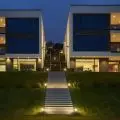On the one hand, the renovated Imperial Castle, on the other - the deteriorating former synagogue. Poznan's approach to the heritage of other cultures is not short of paradoxes and silences. The post-German architecture is doing much better than the few traces of Jewish presence.
Last year, in their spare moments from lockdown, Poznań residents admired the newly restored interiors of the former Imperial Castle. The west wing has been painstakingly restored and forms a successful whole with the main part of the castle rebuilt in a contemporary spirit eight years ago (design: Toya Design). Even earlier, the castle's facades were renovated.
The castle was taken care of perfectly, even though its original function was aimed at Polish society. The huge neo-Romanesque residence for the German emperor from 1910 (designed by Franz Schwechten) was meant to emphasize Prussian rule in the east. In turn, during World War II, the castle was being prepared for Hitler's residence. The Germans then rebuilt it, and gave the previously historicizing interiors heavy forms close to the Berlin Reich Chancellery.
Despite the symbolism, the castle did not share the fate of the demolished Alexander Nevsky Cathedral in Warsaw. It survived - both after the partitions and after the last war, although since 1945 - with its tower trimmed to 75 meters. Practical considerations spiced with dignity sauce won out. In 1934 a film about Poznan reported:
Alien to us in spirit, the edifice of the former imperial castle [...] became a symbol of historical justice, housing the representative salons of the President of the Republic, and the Collegium Maius of the university on the first floor.
After the war, academics and the president gave way to the Municipal National Council, and then to culture. Since the 1960s, the Palace of Culture operated in the castle, and since the 1990s - the Castle Cultural Center. Thanks to this function and a very interesting offer, the heavy edifice has been tamed and no longer evokes bad associations. On the contrary - residents like it and are curious about its history and secrets.
The castle during the Ethno Port festival
photo: Jakub Glaz
Since the castle survived, it was even easier for other representative edifices in its vicinity, also built after 1900 as part of the modernization and expansion of the city. In the Second Republic, no one seriously thought about demolishing the neoclassical German theater, the neo-Renaissance edifice of the Royal Academy, the Evangelical House, or even the neo-Baroque headquarters of the Colonization Commission - an institution used to Germanize Greater Poland. Before the war, Poles knew the origins of these buildings, had an emotional relationship to them, but recognized them as their own. On the other hand, after the war, it was not explained very thoroughly to the younger generations where the monuments so readily reproduced on postcards and in albums came from in the city.
For decades, the origins of the more ordinary architecture of the downtown area, the historic districts of Jeżyce, Wilda and Lazarus, and the villa-like Sołacz were also passed over in silence. Already the aforementioned 1934 film showed tenements from before the first war as a district with a
typically modern architecture [which] closes the picture of the architecture of the new Poznań [...] a stronghold of Polishness on the western fringes of Poland.
This does not mean, however, that the tame post-German houses, schools or offices were viewed positively at the time. Their "heavy" or "overloaded" forms were contrasted with new Polish buildings that drew on models from the Renaissance, Baroque and Classicism, Art Déco and, from the 1930s, the architecture of moderate modernism. Besides, already during the partitions, Polish investors were more willing to hire native architects, including the most famous - Roger Slawski, whose works were different from the eclectic or Art Nouveau realizations of their German colleagues.
For decades, buildings with clinker facades also had a bad press. Regardless of their form and quality, they were referred to as "Prussian," were often plastered and similar solutions were avoided in new buildings. Back in the 1990s, an architect who clad her postmodern infill with brick was scolded by senior colleagues for her "Prussian" tendencies. Clinker was in fact "disenchanted" and considered familiar only during the construction of the Old Brewery (design: Studio ADS, 2003, 2007), whose new elevations, referring to the historical ones, were flooded with a sea of bricks.
{Image@url=https://cdn.architekturaibiznes.pl/upload/galerie/47038/images/original/17bb93b1a534beaa4d9deffa99afde95.jpg,alt=Stary Old Brewery - walls faced with clinker; view from Dabrowski Park,title=Stara Browar - walls faced with clinker; view from Dabrowski Park}
Stary Browar - walls faced with clinker; view from the side of Dabrowski Park
photo: Jakub Głaz
German architecture was also not respected by Wladyslaw Czarnecki - a respected architect and urban planner of Lviv origin, who headed the Department of City Expansion in the 1930s. However, he quickly came to appreciate German urban planning, which shaped much of Poznan at the time. He assimilated its principles and creatively developed them. Today, a significant number of Poznań residents miss both the post-German order and architecture. Suffice it to say that in 2020 the annual Jan Baptista Quadro award for the best new (!) realization, the jury awarded... the reconstruction of a turn-of-the-century tenement house (design: CDF Architects), which had collapsed in a building disaster a few years earlier.
The 


A newly built tenement house on Ogrodowa Street, whose elevations are a reconstruction of the original (proj.: CDF Architekci)
photo: Jakub Glaz
On the other hand, almost zero sentiment is attached by Poznań residents to the very poorly realized architecture of the occupation period. Few realize how much the Germans built or remodeled in the "alte deutsche Stadt Posen." They realized then, among other things, decent housing estates in Jeżyce, Debbiec, Grunwald and Sołacz. On the other hand, they erected barracks on the outskirts for Poles displaced from tenement houses. Many were still standing a few years ago, and in some - horror of horrors - Poznań residents still live today.
{Image@url=https://cdn.architekturaibiznes.pl/upload/galerie/46982/images/original/a822c2297266e3037cb282e555951aca.jpg,alt=baraki for Poles from World War II on Opolska Street,title=barracks for Poles from World War II on Opolska Street}
barracks for Poles from World War II on Opolska Street
photo: Jakub Głaz
During the war, the regulation of the Warta River and the reconstruction of the Old Town and Chwaliszewo began as well. The Germans also remodeled not only their own castle, but even the annexation-era tenements and hotel on Liberty Square, deeming their forms too fanciful and not National Socialist enough. They even carried out a simplified sanitation of the facades of the Old Market Square tenements, something that only pre-war advocates of a similar solution could dream of.
The most spectacular and at the same time barbaric alteration, however, was the reconstruction of the New Synagogue in the Old Town. The Germans simplified and lowered the magnificent edifice with neo-Romanesque and neo-Moorish features from 1907 (designed by Julius Senft, Gotthold Riegelmann) converting it into a municipal swimming pool. After the war, Poles, without much remorse, bathed in the former synagogue until 2011.
former synagogue
photo: Jakub Głaz
Finally - and here we come to matters that were almost silent until recently - the occupiers created a new recreational reservoir (today's Lake Rusalka) on Golęcin and began construction of a similar reservoir on Malta (completed after the war; today's Lake Malta). Both were built with the hands of prisoners, mostly Jewish. The banks and bottom of Rusalka were fortified with matzevot from a liquidated Jewish cemetery. And so for 75 years, Poznań residents have been resting right next to the tombstones hidden underwater.
Thus, it is clear that the few traces of Jewish presence in the city are doing much worse than the objects erected by their persecutors. Over the years, neither the local government nor the community of historians or architects has stood firm on the issue of the former synagogue. Until recently, the edifice belonged to the Jewish community, but the latter has failed to deal with the development of the desacralized temple into a Center for Judaism and Tolerance. However, no clear and firm signal has come from the local authorities to participate in the building's restoration. Worse: well-known art historian (and right-wing politician) Marcin Libicki proposed in 2006 that the edifice be demolished because it was a tool of the Kulturkampf and intended to "diminish the manifestations of Polish and Catholic influence in the city."
After the fiasco of the Jewish community's ambitious ideas, the media reported on plans to install a hotel in the former synagogue. Preliminary and not very successful visualizations of the adaptation leaked out. They alluded to the original form of the synagogue, but without attempting a literal reconstruction. Eventually, the municipality sold the building to a private company in 2019, announcing that it would house the Museum of Wielkopolska Jews. Little is known about the museum, while the buyer commissioned another version of the hotel project. The matter is dragging on, only the building is deteriorating faster and faster.



former synagogue, view from Wolnica st.
photo: Jakub Głaz
The city authorities are also in no hurry to get the broken matzevot out of Lake Rusalka. Two years ago, the issue was made public by social activists Maciej Krajewski and Aleksander Przybylski. They appealed for the extraction of all the plaques, but - so far - the slabs have been fished out of Rusalka sporadically, when the water level drops. Last year, some finally made it to the lapidarium on Glogowska Street, next to the site of the Jewish cemetery liquidated by the Germans and later occupied by the fair.
And what about the appeal of community activists? The local government is "in favor," but cools the enthusiasm, explaining the lack of finances and the complicated nature of the project. For the time being, last September, at the lakeshore, the socialists led to the erection of a pylon informing about Rusalka's history. They paid for it with money from an online fundraiser.















































